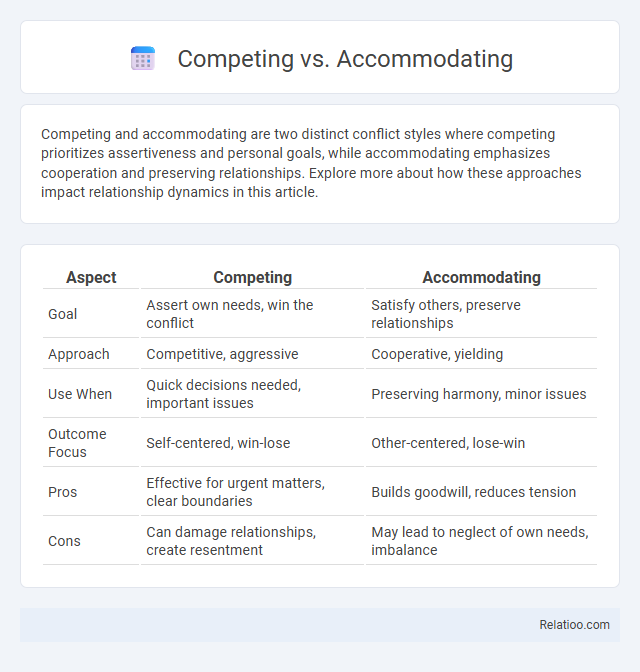Competing and accommodating are two distinct conflict styles where competing prioritizes assertiveness and personal goals, while accommodating emphasizes cooperation and preserving relationships. Explore more about how these approaches impact relationship dynamics in this article.
Table of Comparison
| Aspect | Competing | Accommodating |
|---|---|---|
| Goal | Assert own needs, win the conflict | Satisfy others, preserve relationships |
| Approach | Competitive, aggressive | Cooperative, yielding |
| Use When | Quick decisions needed, important issues | Preserving harmony, minor issues |
| Outcome Focus | Self-centered, win-lose | Other-centered, lose-win |
| Pros | Effective for urgent matters, clear boundaries | Builds goodwill, reduces tension |
| Cons | Can damage relationships, create resentment | May lead to neglect of own needs, imbalance |
Introduction to Competing and Accommodating Styles
Competing and accommodating are two primary conflict management styles that influence how individuals approach disagreements and assert their needs. The competing style emphasizes assertiveness and a desire to win, often prioritizing your goals over others' concerns, while the accommodating style prioritizes cooperation and maintaining harmony by yielding to others' preferences. Recognizing these patterns helps you adapt your approach for effective conflict resolution, balancing assertiveness with empathy to achieve mutually beneficial outcomes.
Defining Competing Conflict Style
The competing conflict style emphasizes assertiveness and a desire to win, prioritizing individual goals over relationships. It is characterized by high assertiveness and low cooperativeness, often leading to confrontational interactions. This style is effective in situations requiring quick, decisive action but can damage collaboration if overused.
Understanding the Accommodating Approach
The accommodating approach in conflict resolution prioritizes maintaining harmony by yielding to others' needs and preferences, often at the expense of one's own interests. This method is effective in preserving relationships and avoiding escalation when issues are minor or when the other party holds more power. Understanding accommodating requires recognizing its strategic use to build goodwill, though overuse can lead to resentment or imbalance in collaboration.
Key Differences Between Competing and Accommodating
Competing involves assertively pursuing one's own goals at the expense of others, emphasizing winning and control, whereas accommodating prioritizes others' needs, often sacrificing personal desires to maintain harmony. The key difference lies in the balance of assertiveness and cooperativeness: competing is high in assertiveness and low in cooperativeness, while accommodating is low in assertiveness and high in cooperativeness. This fundamental contrast influences conflict resolution strategies, with competing favoring dominance and accommodating focusing on yielding.
When to Use Competing Strategies
Use competing strategies when quick, decisive action is needed, especially in high-stakes situations where your goals are critical and non-negotiable. This assertive approach is effective in emergencies, protecting your rights, or when upholding important principles. Understanding when to prioritize competition over accommodation or pattern-based negotiation ensures your interests remain a top priority without compromising your position.
Best Scenarios for Accommodating
Accommodating conflict management is best suited for situations where maintaining harmony and relationships outweighs winning an argument, especially in low-stakes conflicts or when the other party has more expertise. It proves effective in resolving disputes quickly and preserving long-term cooperation in teamwork or customer service settings. This style is ideal when one party's concession promotes goodwill or when the issue is more important to the opponent than to oneself.
Pros and Cons of Competing in Conflict Resolution
Competing as a conflict resolution style emphasizes assertiveness and quick decision-making, making it effective in situations requiring decisive action or protection of vital interests. Its pros include fostering clear leadership and advancing personal or organizational goals, while cons involve potential damage to relationships and escalation of tensions due to a win-lose approach. This style contrasts with accommodating, which prioritizes harmony but risks neglecting personal needs, and with patterned responses that may lack flexibility.
Advantages and Disadvantages of Accommodating
Accommodating conflict style prioritizes cooperation and maintaining harmony by yielding to others' demands, which can quickly resolve disputes and preserve relationships. Its advantages include fostering goodwill and reducing immediate tension, but disadvantages involve potential neglect of one's own needs, leading to resentment and imbalance in decision-making. Overuse of accommodating may empower dominating parties while undermining long-term assertiveness and self-advocacy.
Real-Life Examples: Competing vs Accommodating
In real-life scenarios, competing involves asserting your own needs aggressively, such as negotiating a higher salary despite initial resistance. Accommodating occurs when you prioritize others' desires, like agreeing to a colleague's preferred meeting time to maintain harmony. Your ability to recognize when to compete or accommodate can improve conflict resolution and relationship dynamics in both personal and professional settings.
Choosing the Right Style for Effective Outcomes
Choosing the right conflict resolution style--competing, accommodating, or pattern--depends on the context and desired outcome to achieve effective results. Competing is best for urgent decisions requiring assertiveness, accommodating suits preserving relationships by yielding, while pattern recognition helps identify recurring dynamics to adapt strategies accordingly. Understanding when to apply each style enhances communication, fosters collaboration, and drives successful conflict management.

Infographic: Competing vs Accommodating
 relatioo.com
relatioo.com